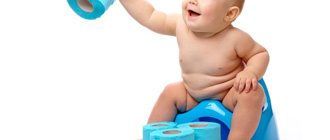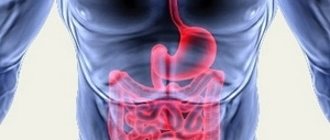Causes of constipation after childbirth
The regularity of bowel movements is affected by changes in the postpartum period, when the female body begins to rebuild. On the one hand, the tone of the colon is influenced by hormonal levels, which change dramatically after the birth of a child, on the other hand, the intestines continue to experience slight pressure from the uterus while it returns to its “non-pregnant” size within 6-8 weeks1.
In addition, some reasons that disrupt the regularity of bowel movements in pregnant women do not always disappear after childbirth1. Thus, the development of constipation in women who are breastfeeding is promoted1:
- irrational diet - lack of dietary fiber in the diet3;
- insufficient physical activity1;
- any stress that a young mother experiences - conflict situations, long travel or changes in usual lifestyle in connection with the birth of a child1,4;
- stretching of the muscles of the perineum and abdomen, which do not sufficiently support the intestines and other internal organs1;
- chronic diseases, for example, hemorrhoids2, anal fissures3, diseases of the digestive system, thyroid gland, adrenal glands1;
- medications1 or dietary supplements2 prescribed by a doctor during pregnancy or after childbirth.
Postpartum constipation is a fairly common occurrence after a cesarean section, the application of obstetric forceps or an episiotomy - cutting of the perineum2,3. According to some studies, in the first days after a cesarean section, constipation was observed in 57% of postpartum women7.
The reason for stool retention in these cases may be:
- Presence of surgical sutures. The surgeon places sutures at the site of perineal ruptures or surgical wounds on the anterior abdominal wall. Sometimes, due to fear that they will separate or weaken, a woman does not push, so the intestines do not empty completely1,2. In addition, pain at the site of the perineal incision may interfere with defecation7.
- Atony (weakening of tone) of the intestines is a common reaction to surgery, due to which peristalsis (wave-like contractions of the intestinal wall) simply becomes ineffective1.
to come back to the beginning
Constipation after childbirth while breastfeeding
Types of constipation
This is what they call absence
The patient has had defecation for at least three days, it is painful, and the stool is dry and hard.
As practice shows, constipation bothers women in the first weeks after the baby is born.
• They are divided into two types:
1. Atonic
.
They occur due to a decrease in intestinal muscle tone. His peristalsis becomes weak, feces move slowly.
This type of constipation often “delights” a woman after a cesarean section. When defecating, the first stool is dense, then soft, and the latter may even be liquid.
2. Spastic
.
They occur due to stress, fear, and nervous tension. The tone of the muscle wall is increased. The intestines are “squeezed”, which slows down the movement of feces
.
Defecation is painful and stool is scanty. The urge to go to the toilet occurs frequently, but it is false or with a small amount of bowel movements.
Why does constipation occur during lactation?
This problem makes itself felt for the following reasons:
• Soreness of the perineum after childbirth
.
It is always felt by those women who have had ruptures and cuts in the perineum (episiotomy or perineotomy).
• Pain in the suture area after cesarean section.
• Fear of straining after natural childbirth. Overstretching of the abdominal wall
during pregnancy and weakness of the abdominal muscles after childbirth.
• Enlarged uterus pressing on the intestines in the first days after childbirth
.
• Lack of physical activity.
• Emotional stress and fatigue associated with taking on new responsibilities.
• Fluid deficiency, improper drinking regimen.
• Hemorrhoids that worsen after childbirth
.
The main cause of postpartum constipation during lactation is nutrition. As a rule, it lacks fiber and coarse fibers.
Indeed, in most cases, nursing mothers are afraid to introduce vegetables, berries and fruits into their diet due to the risk of allergic reactions.
How to cope with constipation during lactation
Usually in the first period
After the baby is born, young mothers cope with this problem without the use
of medications.
The main method of normalizing stool is
correcting nutrition and drinking regimen
. It is also important to normalize the emotional background.
Let me remind you that the main catalyst for intestinal function is
are dietary fiber (fiber) found in vegetables, salads, fruits, cereals and dried fruits.
Women are afraid to introduce such products into their menu because of the risk of intestinal colic and allergies in the baby
, especially in the first month after childbirth. After all, the period of three months of a baby’s life is the most problematic.
's digestive system is developing
, not all the necessary enzymes are present in his intestines, so even harmless food products can provoke
gas formation and allergies.
But you cannot exclude fruits and vegetables from your diet.
Just as you should not eat legumes, exotic vegetables and berries.
It is advisable to include only those grown in your region in your diet. Experts recommend that in the beginning, do not eat raw vegetables, but boil,
stew, or bake them.
Then move on to eating them raw. Do not forget that all new products on the menu must be introduced gradually and the baby’s reaction must be carefully monitored. Fermented milk products are excellent stimulants of intestinal motility
.
They populate the digestive tract with beneficial bacteria and thereby prevent constipation in nursing women. Therefore, it is recommended to consume cottage cheese, yoghurt,
kefir, and fermented baked milk daily.
Nutritionists advise during lactation
consume vegetable oil on an empty stomach.
The product helps soften the food mass and facilitate its better movement to the rectum. This can be flaxseed, olive and sunflower oils.
Also has a laxative effect
Prunes and figs have this property, and you can use them to prepare decoctions.
Fennel, anise and cumin also help cope with constipation during breastfeeding. These products are brewed and the infusion is drunk in small portions throughout the day
. Women during lactation should drink two liters of fluid per day, including regular drinking water.
Diagnosis of constipation after childbirth
In adults, including women who are breastfeeding, constipation is diagnosed if5:
- stool is observed less than 3 times a week;
- feces become dense;
- you have to push hard or partially remove stool with your finger;
- during pushing there is a feeling of “blocking” of feces in the rectum;
- After defecation, there is a feeling of incomplete bowel movement.
When such symptoms persist for more than 3 months, constipation is considered chronic or persistent5.
Long-term accumulation of feces in the colon can lead to various disorders, so constipation should not be ignored1 - you should understand their cause and alleviate unpleasant symptoms.
Treatment and prevention of constipation during breastfeeding
Treatment of constipation is always comprehensive4 and includes proper nutrition, physical activity and drug therapy1.
to come back to the beginning
Nutritional Features
The diet is selected taking into account the mother’s tolerance to foods and possible allergic reactions in a breastfed baby1.
To prevent postpartum constipation, you should adhere to the following recommendations:
- Don't starve yourself when trying to lose weight quickly. Research shows that during breastfeeding, the deficiency in the intake of proteins, fats and other essential substances in women is approximately 20%. Therefore, it is important to ensure that the diet meets the energy, vitamin and mineral needs of the breastfeeding mother and baby6.
- Eat food at least 4 times a day1, in small portions4, do not overeat6.
- Eat enough fiber. It is worth adding vegetables, fruits, and whole grain cereals to the menu, especially oatmeal6.
- Drink about 1.5-2 liters of liquid during the day2, if there are no contraindications, this speeds up the movement of feces. Mineral waters are suitable: if you are prone to intestinal cramps and abdominal pain, you can drink them warm1.
Physical activity
Nursing mothers can get rid of constipation after childbirth by special exercises, swimming and physical therapy. Regular exercise or exercise for 5-10 minutes a day will help you get rid of extra pounds gained during pregnancy. In addition, any physical activity improves the well-being and emotional state of the mother and helps her gain strength1.
In order for the training to be beneficial, you should consult with your doctor and find out what exercises are allowed in the postpartum period.
Massage
Self-massage is useful for restoring intestinal function. It is done standing or lying down. With light movements, the palms are drawn from the right lower abdomen up, reaching the liver, then stroking the area above the navel and down to the left groin area. Gradually, the movements need to be accelerated so that they have a vibrating effect on the stomach and become wave-like1.
to come back to the beginning
Drug treatment
Drug treatment of postpartum constipation involves the use of laxatives. Like other drugs that are used during pregnancy and lactation, they must meet the main requirement - safety for mother and baby. Some drugs, when taken orally, are absorbed into the blood and excreted in milk9. Therefore, a laxative for constipation in women who are breastfeeding should be prescribed by a specialist.
It is possible to prescribe laxatives from the following groups8:
- volumetric - increase the volume of feces, stimulating intestinal function.
- osmotic - increase the fluid content in the intestinal lumen, soften stool and facilitate its excretion.
- stimulating - act locally, irritating the receptors of the colon.
- softeners - facilitate the movement of feces through the intestines.
For a gentle and painless release of the rectum from feces, Microlax® can be used in the form of a microenema10. According to the instructions for medical use, it is indicated both during pregnancy and lactation10.
Microlax ® contains three active ingredients:
- sodium citrate - displaces bound water from dense feces;
- sodium lauryl sulfoacetate - dilutes stool;
- sorbitol - increases the flow of water into the intestinal lumen.
As a result of the complex action, Microlax ® softens stool and facilitates bowel movements, while it acts only on stool in the rectum, does not affect the functioning of other parts of the gastrointestinal tract and is not addictive11. The drug can help with constipation within 5-15 minutes10.
After giving birth, days begin for a woman full of the joy of motherhood and pleasant worries. Young mothers closely monitor the health of their child, try to adhere to the rules of breastfeeding and follow the recommendations of the pediatrician. At the same time, in the postpartum period, the health of the mother requires no less attention. To prevent constipation after childbirth, patients should be advised to change their diet, be physically active, do self-massage to stimulate bowel function, and, if necessary, choose a laxative.
to come back to the beginning
LAXATIVES - FOR MOTHER AND CHILD
Preferanskaya Nina Germanovna
Associate Professor, Department of Pharmacology, Faculty of Pharmacy, First Moscow State Medical University named after. THEM. Sechenova, Ph.D.
With prolonged and frequent retention of food, putrefactive microflora develops in the intestines, toxins and toxic waste products are formed, which poison our body and lead to various pathological processes. The same thing happens with constipation. It is imperative to empty the intestines and restore gastrointestinal functions. You need to start with a diagnostic examination of the causes of constipation and changes in diet.
Laxatives should be used only in exceptional cases and for a short period of time; abuse of use is unacceptable! Long-term continuous use reduces the sensitivity of the nerve endings of the intestine, disrupts motor-evacuation function, and causes intestinal atony. “Rebound” syndrome occurs, which leads to stagnation of feces and new constipation. Toxins accumulate in the intestines, and the absorption of nutrients, vitamins and microelements is impaired. Uncontrolled use of laxatives leads to disruption of intestinal function and digestion, the water-salt balance changes, and the symbiotic intestinal microflora is destroyed. With long-term use of laxatives, addiction occurs, i.e. the drugs cease to have an effect on the body and exhibit a laxative effect.
The contents of the large intestine of an adult always contain bacterial microflora; in a newborn, the microflora of the large intestine is sterile. During the first months of life, this section is populated by intestinal flora involved in the bacterial decomposition of food. In infants and young children, the main food source is milk, which contains fat, so fat is the main source of energy. Impaired digestion and absorption of fats in infants is more dangerous than in adults, for whom, with normal nutrition, the main source of energy is glucose and, to a lesser extent, fats. With a balanced diet, the processes of fermentation and decay are mutually balanced. However, some food components can remain in the sigmoid colon for up to 3 days. Constipation is understood not only as a decrease in stool or retention of stool for more than 36 hours.
In the first weeks of a child’s life, the frequency of stools is 4 times a day; by 4 months - 2 times a day; The stool frequency of a 4-year-old baby (96%) ranges from 3 times a day to 3 times a week.
Most often, constipation develops in a child's body as a result of decreased fiber intake and physical inactivity (sedentary lifestyle, prolonged immobility in front of the TV, computer). The development of constipation is also facilitated by helminthic infestations or previous intestinal infections.
From a young age, it is necessary for a child to develop behavioral stereotypes: regularly visiting the toilet at the same time, encouraging the baby after productive bowel cleansing. A child should not be scolded, shamed, much less punished. School-age children are very often embarrassed to ask to leave the classroom to relieve themselves and often try to restrain this act. Under certain (extraordinary) circumstances, the defecation reflex can be restrained, but not very often, because Frequently holding back the urge to defecate increases the reflex threshold, and this can lead to constipation.
Pregnant women often have to deal with the problem of difficulty defecating. In the body of pregnant women, the level of progesterone (hormone of the corpus luteum) is increased, which relaxes not only the muscles of the uterus, but other smooth muscle organs, and the motor activity of the intestines and urinary tract decreases. In the period from 16 to 36 weeks, the level of motilin (hormone of the mucous membrane of the duodenum) decreases, which enhances gastrointestinal motility. During this period, some women are prescribed tocolytic drugs.
, relaxing smooth muscles of blood vessels and internal organs (bronchi, uterus, gastrointestinal tract).
At different periods of pregnancy, for the normal development of the fetus micronutrients
,
calcium, iron, magnesium preparations
or
essential vitamins
and
vitamin-mineral complexes
, compiled specifically for pregnant women, are prescribed:
“Materna”, “Undevit”, “Pharma-med Lady's formula for pregnant women” and lactating women
. In subsequent months of pregnancy, the development of delayed bowel movements is facilitated by: decreased physical activity (bed rest), limited fluid intake, changes in food preferences (diet), as well as a growing uterus, the enlargement of which leads to mechanical compression of the intestines. These factors lead to impaired peristalsis and constipation. Taking the wrong laxatives can cause a miscarriage. Pregnant women with constipation should not push too hard; muscle tension also contributes to abortion.
Laxatives are approved for use as over-the-counter products; many of the drugs are registered as dietary supplements (BAS) for food. Attention
!
Taking most laxatives is contraindicated for pregnant women!
Which laxatives should not be taken by pregnant women, but can be taken by children?
Saline laxatives - Sodium sulfate
and
Magnesium sulfate
-
should not be used by pregnant women!
The mechanism of action of the drugs is based on poor absorption in the intestine, which creates increased osmotic pressure in it and retains water. In this case, the contents of the intestine liquefy and increase in volume, which leads to mechanical irritation of its walls and a reflex increase in the peristalsis of smooth muscles, incl. and myometrium. When using these drugs orally, it is necessary to drink plenty of water (200–250 ml), and this is an additional burden on the kidneys and heart of pregnant women.
Children over 12 years old can take sodium sulfate
and
Magnesium sulfate
orally, 10 g per 0.5 glass of water, 1 time per day. Children aged 6–12 years are prescribed from 5 to 10 g (i.e., from half to the whole volume of a solution prepared at the rate of 10 g per 0.5 glass of water). In children under 6 years of age, the drug can only be used as prescribed by a doctor. Daily doses are determined at the rate of 1 g per 1 year of life. It is possible to use the drug in the form of enemas (50–100 ml of 20–30% solution).
◊ When taking Magnesium sulfate
allergic reactions, colicky abdominal pain, flatulence are possible.
Macrogol (Lavacol, Forlax, Fortrans)
can only be taken by adults;
pregnant women and children are contraindicated in taking medications
.
The drug is not absorbed in the intestines, is not metabolized and is excreted unchanged in feces, so it can be used by women during breastfeeding. Available in powder form for the preparation of a solution for oral administration (pack of 10 g, 14 g). ◊ When used, it can cause nausea, vomiting, flatulence, diarrhea and abdominal pain, and this is undesirable for pregnant women. Fortrans
is available in a pack. 64 g each, it is used during the preparation of the patient for surgery or for various studies of the gastrointestinal tract.
Natural preparations also increase the volume of intestinal contents: Seaweed (Kelp), Laminaria thallus, Laminaride, Sividal
(dietary supplement) and
flaxseed mucilage
.
The laxative effect of these drugs is associated with swelling of the intestinal contents and mechanical irritation of its receptors. Sea brown algae contains iodine and bromide salts, alginates (calcium salts of alginic acids), mannitol, kelp polysaccharides, vitamin C and other biologically active substances. The drugs can be recommended for adults and children over 12 years old, 1 TB each. or 1 tsp. powder 1 time per day with meals. In pregnant women
, due to the fact that to achieve a laxative effect when using these drugs, a large dose and plenty of fluids are required,
a miscarriage can be caused
.
As a laxative during pregnancy, the drug
Castor bean seed oil
(
Castor oil) is contraindicated
, because When broken down in the duodenum, ricinolic acid is formed, which causes chemical irritation of intestinal receptors; the resulting glycerol softens and enhances the movement of feces, which means that at the same time, in addition to the laxative effect, a reflex contraction of the uterine muscles occurs. The absorption of water is delayed, the volume of intestinal contents increases, which reflexively increases peristalsis.
Castor oil as a laxative
prescribed for children - 5-15 g per dose (tsp - 5 g) or 5-10 caps. within 30 min.
Pregnant women should not use herbal
laxatives containing anthraglycosides
-
buckthorn alder bark drug (Ramnil), Sennosides A and B (Glaxena, Senadexin, Senade, Senalex, Tisasen)
, because they are broken down into active substances: emodin (trioxymethylanthraquinone) and chrysophanic acid (dioxymethylanthraquinone), which irritate the intestinal interoreceptors and cause increased peristalsis with subsequent emptying, the latter may be accompanied by spastic phenomena, pain, flatulence, because These plants contain resinous substances that irritate the intestines.
Anthraglycosides (Senosides A and B)
contain dry senna extract and can be used as a laxative for children from 1 to 6 years old, the dose is one third, and for children 6–12 years old - half of the adult dose (see instructions).
Preparations containing senna leaf powder (cassia), and these are Antrasennin, Agiolax, Kafiol, Regulax, Sennalax, Slabilax, Fitolax, Frutolax
-
Contraindicated for pregnant women
.
According to some sources, long-term use of these drugs can cause a teratogenic effect (external deformities of the fetus). Senna is also included in laxative tea No. 2
.
Please note that children under 4 years of age should not take synthetic laxatives :
Bisacodyl (Dulcolax), Sodium picosulfate (Guttalax, Slabilen)
, which are not absorbed in the small intestine, cause chemical irritation of the receptors of the colon mucosa, increasing peristalsis. The drugs are prodrugs - Bisacodyl is hydrolyzed in an alkaline environment, and Sodium picosulfate is hydrolyzed under the influence of intestinal microorganisms to form active metabolites. These drugs have a laxative effect after 8–10 hours; when administered rectally, rapid emptying occurs within 1 hour. They should not be used for more than 10 days; dehydration, electrolyte imbalance and hypokalemia are possible. Side effects of these drugs include abdominal pain and diarrhea. Bisacodyl is taken orally in the evening before bed with a small amount of water. Prescribed to adults and children over 14 years of age - 5-15 mg; children from 8 to 14 years old - 5–10 mg. In the form of a rectal suppository, children over 8 years of age are prescribed - 1 (10 mg) in the morning, adults and children over 14 years of age - 1-2 (10-20 mg).
Nursing mothers should take the drug with caution, because it passes into breast milk and may cause diarrhea in the infant.
Sodium picosulfate can be used during lactation (FDA category B), because No active metabolites were found in breast milk. The drug is available in dropper bottles of 15 and 30 ml (7.5 mg/ml), and is dispensed in drops (1 ml = 15 drops). Guttalax
taken orally before bedtime, prescribed to children from 4 to 10 years old, 5–10 drops; children over 10 years old and adults - 10 drops at night. The laxative effect occurs in the morning.
Lactulose (Duphalac, Livolyuk-PB, Normaze, Portalac, Romphalac)
when taken orally, it normalizes intestinal function without affecting stool frequency, acts gently, and the effect develops after 24–48 hours.
Under the influence of bacterial enzymes, it is broken down into low molecular weight organic acids. Lactulose
stimulates the proliferation of bifidobacteria and lactobacilli. Beneficial intestinal microflora provides impermeability to potentially pathogenic bacteria and suppresses their growth and reproduction, restoring a more favorable balance.
In the lumen of the large intestine, the pH decreases, the intestinal contents become acidified, the formation and absorption of nitrogen-containing toxins is inhibited, ammonia is removed from the body, and a detoxification effect occurs. The absorption of phosphates and calcium salts, necessary for normal growth of bone tissue of the fetus, infants and small children, improves. Calcium takes part in the work of many enzyme systems and ensures muscle contraction. When using the drug, side effects may occur - nausea, diarrhea, flatulence, pain in the abdominal area.
Duphalac
– syrup (100 ml bottle) is prescribed for oral administration, for adults the initial dose is 15–45 ml, the maintenance dose is 15–30 ml.
There is no information about penetration into breast milk; the drug has no teratogenic, embryotoxic or fetotoxic effects on reproductive function. Children under 1 year of age can use 5 ml; from 1 year to 7 years - 5-10 ml, from 7 to 14 years - 15 ml. Contraindications include lactose and galactose intolerance, and caution should be exercised if you have diabetes. Normaza
- syrup (100 ml bottle) is prescribed to children under 14 years of age - in the first 3 days - 15 ml, then - 10 ml / day;
under the age of 6 years - 5–10 ml/day, and for infants - 5 ml/day. The drug Normolakt
is a syrup produced in a bottle. 100 and 200 ml, also containing lactulose, are prescribed in the doses indicated above, only for infants the dose is less - 2.5 ml / day.
Osmotic laxatives of plant origin
can be used during lactation.
Contraindications include children under 12 years of age and poorly controlled diabetes mellitus. ◊ When used, allergic reactions may occur, and in the first days of use, flatulence and an increased feeling of fullness in the stomach, which disappear later. Herbal medicines are obtained from the powdered shell of the seeds of Plantain oval (Mukofalk) and the seeds of Plantain flea (Naturolax, Natur-ker)
.
Hydrophilic fibers retain fluid in the intestines, increase the volume in quantities many times greater than their mass, and soften the consistency of stool, facilitating the passage (French passage - author's note) of intestinal contents, and regulate intestinal activity. The drug has a beneficial effect on intestinal microflora and lipid metabolism, when the mass of intestinal bacteria increases and the amount of bacterial breakdown products increases, especially short-chain fatty acids, which regulate intestinal motility. Mucofalk
normalizes intestinal function without being a classic laxative (it is effective not only for constipation, but also for functional diarrhea) and does not have an irritating effect.
1 sachet or 1 tsp. Mucofalk orange granules
are dissolved in 150 ml of cold water, stirred and the prepared suspension is immediately drunk, followed by another glass of liquid (you need to drink at least 1.5 liters of liquid per day, and for pregnant women this is a big load).
Orally for adults (pregnant women - for constipation) and children - 5 g (1 sachet or 1 tsp granules) 2-6 times a day. Naturolax is contraindicated during pregnancy
.
Lactitol (Lactitol monohydrate, Exportal)
- a means for maintaining and restoring normal intestinal microflora, providing a controlled laxative effect. The drug acts only on the large intestine, is broken down by microflora into low molecular weight organic acids, increases osmotic pressure and increases the volume of feces, softens and facilitates bowel movements after 24 hours. When taking new generation drugs based on lactitol, the level of cholesterol in the blood decreases and there is no addiction.
Can be used during pregnancy and lactation, as well as for children over 1 year of age. Take orally before meals: children from 1 year to 6 years - ½–1 tsp. powder (2.5–5 g) per day; aged 6 to 12 years - 1–2 tsp. (5–10 g); from 12 to 16 years old - 1-2 packs. (10–20 g) and adults - 2 packs. per day (20 g). After restoration of the laxative effect and normalization of intestinal function, the dose is gradually reduced. When used, side effects may occur: flatulence, discomfort in the intestinal area. Possible use for diabetes mellitus, because does not affect blood glucose levels.
Glycerol
(suppositories with glycerin) has a combined laxative effect due to the ingredients included in its composition. Glycerin envelops and lubricates the contents and mucous membrane of the colon, thus softening the movement of feces, and stearic acid (sodium stearate), when administered orally, interacts with interoreceptors, has an irritating effect on them and reflexively enhances intestinal motility and stimulates the act of defecation. It has a dehydrating, astringent and antimicrobial effect. The action develops within 15–20 minutes. Long-term use is not recommended to avoid the phenomenon of irritation of the rectum; it should not be used for hemorrhoids, fissures, inflammatory diseases and tumors. Glycerin suppositories are produced under the TN "Glicelax": for adults - 1.5 g, for children - 0.75 mg, prescribed from 3 months of age with use for no more than 7 days.
Liquid paraffin (Vaseline oil)
softens feces and lubricates the contents of the large intestine, facilitating the movement of chyme through the intestines. Taking this drug slows down the absorption of water, which prevents the formation of stool. Laxative softeners lead to psychological dependence. During pregnancy, it is not advisable to use Vaseline oil, because microelements - magnesium and potassium - will be poorly supplied to the body. Vaseline oil interferes with the absorption of fat-soluble vitamins and is used mainly in hospitals.
“Lactulose + Lignin hydrolyzed” - a combined preparation
under the technical name "
Lactofiltrum
", contains 120 mg + 355 mg, respectively.
The pharmacological effect is due to the properties of the active components included in the composition. Normalizes the microbiocenosis of the large intestine and reduces endogenous toxic metabolites. Lignin is not absorbed and is completely eliminated from the intestines within 24 hours. Hydrolysis of lactulose occurs in the large intestine. Course duration is 2–3 weeks. Long-term use is not recommended, only on the recommendation of a doctor, because may cause constipation, allergic reactions and abdominal pain. Used in children from 1 year to 3 years, ½ tb. 3 times a day; from 3 to 7 years - 1 TB. 3 times a day; from 7 to 12 years - 1–2 TB. 3 times a day; Children over 12 years of age and adults are recommended 2–3 TB. 3 times a day. ◊ If side effects occur, stop taking. There are no data on the safety of use during pregnancy and lactation
.
Microlax is a combined laxative drug
, produced in the form of a solution for single rectal administration of 5 ml (package - 4 microenemas, which contains Sodium citrate + sodium lauryl sulfoacetate 70% + sorbitol solution). Sodium citrate is a peptizing agent that releases water from stool. Sodium lauryl sulfoacetate thins the intestinal contents. Sorbitol enhances the laxative effect and facilitates bowel movements; the laxative effect occurs within 5–15 minutes. Prescribed for children over 3 years old - 1 microenema (5 ml). The tip should first be lubricated with the contents of the tube and inserted along the entire length; for newborns and children under 3 years old - half the length of the tip. If necessary, the drug can be used during pregnancy and lactation. No special precautions are required. ◊ Side effects - burning in the rectal area, increased sensitivity to drugs.
Wheat bran
- a natural product of high biological activity, necessary for a complete healthy diet, the richest source of dietary fiber, microelements and vitamins: calcium, iron, magnesium, potassium, vitamins E, K, etc.
Dietary supplement (dietary supplement) is a tablet form of high quality natural wheat bran or powder (pressed granules) in a 200 g package. Bran is rich in polyunsaturated fatty acids, which take part in various biochemical processes; dietary fiber binds cholesterol, heavy metal ions and harmful breakdown products of nutrients, and protein-starch mucus removes toxins. By swelling, wheat bran becomes a matrix for the formation of feces and relieves constipation.
Adults and children over 12 years old - 5–7 TB each. 3 times a day before or during meals, washed down with water. Bran can be added to first courses or other liquid drinks (yogurt, kefir, milk, jelly), starting with a small dose - 1-2 tsp. (2–3 tb.), then within a week the daily dose is increased to 30–65 g. The course of administration is 1–2 months.
Bran with succinic acid (100 g), with calcium and seaweed (200 g), with beets (200 g), containing apple and carrot (250 g), milk thistle (200 g), etc. are produced.
When using laxatives, you must remember that this is a short-term necessity. Using these drugs for a long time, there is a risk of completely compromising your health. Many drugs in this group become addictive over time, reduce the laxative effect and do not have the desired effect. Pregnant and lactating women should be very careful when using such medications. In childhood, you need to try to change your diet, be sure to include special exercises that strengthen intestinal function, and teach your child to lead a healthy lifestyle.
Literature:
- T.N. Sokur, N.V. Dubrovina. Constipation during the postpartum period. Consilium Medicum. 2012; 6:60-63
- Response of pregnancy related functional constipation to acupressure in postpartum women. Marwa Abd-El Rahman, Azza Barmoud Nashed, Mona Mohamed Taha and Amir A. Gabr Physical Therapy and Rehabilitation 2022, Volume 5, Article 11 doi: 10.7243/2055-2386-5-11
- E.Yu. Lebedeva, R.Ya. Tatarintseva. The main causes and help for postpartum constipation. Modern scientific research and innovation. 2013. No. 3. https://web.snauka.ru/issues/2013/03/22599
- N.A. Krasnova. Treatment of constipation during pregnancy and the postpartum period. Obstetrics and Gynecology, 2011, No. 7-1.
- Clinical recommendations Constipation in adults (as a manifestation of systemic diseases) Scientific Society of Gastroenterologists of Russia (NOGR) Russian Scientific Medical Society of Therapists (RNSOT). 2019
- V.V. Zubkov. Peculiarities of a woman's nutrition during pregnancy and while feeding a child. Medical Council, 2022, No. 13, pp. 86-93.
- Polushkina E.S., Grigoryan I.E. Functional constipation in pregnant and postpartum women. Medical advice. 2021;(3):77–80. doi: 10.21518/2079-701X-2021-3-77-80.
- Turawa, Eunice & Musekiwa, Alfred & Rohwer, Anke. (2014). Interventions for treating postpartum constipation. The Cochrane database of systematic reviews. 9. CD010273. 10.1002/14651858.CD010273.pub2.
- Barabash N.A., Stankevich S.S., Melnikova U.V. B240. Drug therapy during lactation: methodological. recommendations. Tomsk: Kursiv Publishing House, 2012
- Instructions for use of MICROLAX® microenemas. // Reg. number P N011146/01 // GRLS of the Russian Federation. – URL: https://grls.rosminzdrav.ru/Grls_View_v2.aspx?routingGuid=f052fb31-5426-4bc1-958f-9fce793aa43f&t= (date accessed 07/27/2021).
- Constipation in children. / Edited by S.V. Belmera, A.Yu. Razumovsky, A.I. Khavkin, R.A. Faizullina. – M.: Publishing House “MEDPRACTIKA-M”, 2016, 312 p.









